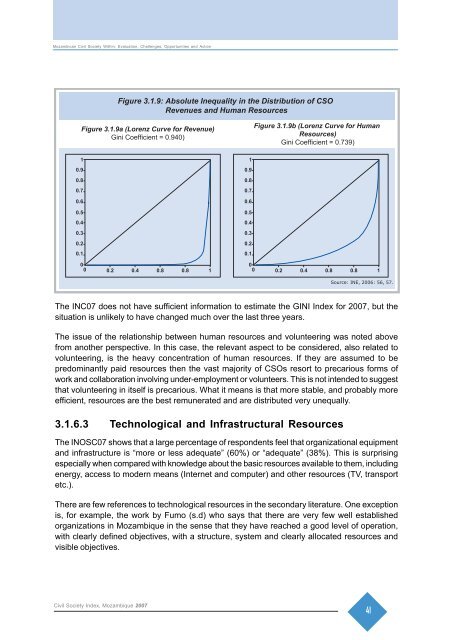Mozambican Civil Society Within: - UNICEF Mozambique - Home page
Mozambican Civil Society Within: - UNICEF Mozambique - Home page
Mozambican Civil Society Within: - UNICEF Mozambique - Home page
You also want an ePaper? Increase the reach of your titles
YUMPU automatically turns print PDFs into web optimized ePapers that Google loves.
<strong>Mozambican</strong> <strong>Civil</strong> <strong>Society</strong> <strong>Within</strong>: Evaluation, Challenges, Opportunities and Action<br />
Figure 3.1.9: Absolute Inequality in the Distribution of CSO<br />
Revenues and Human Resources<br />
Figure 3.1.9a (Lorenz Curve for Revenue)<br />
Gini Coefficient = 0.940)<br />
Figure 3.1.9b (Lorenz Curve for Human<br />
Resources)<br />
Gini Coefficient = 0.739)<br />
1<br />
1<br />
0.9<br />
0.9<br />
0.8<br />
0.8<br />
0.7<br />
0.7<br />
0.6<br />
0.6<br />
0.5<br />
0.5<br />
0.4<br />
0.4<br />
0.3<br />
0.3<br />
0.2<br />
0.2<br />
0.1<br />
0.1<br />
0<br />
0<br />
0.2<br />
0.4 0.8 0.8 1<br />
0<br />
0<br />
0.2<br />
0.4 0.8 0.8 1<br />
Source: INE, 2006: 56, 57.<br />
The INC07 does not have sufficient information to estimate the GINI Index for 2007, but the<br />
situation is unlikely to have changed much over the last three years.<br />
The issue of the relationship between human resources and volunteering was noted above<br />
from another perspective. In this case, the relevant aspect to be considered, also related to<br />
volunteering, is the heavy concentration of human resources. If they are assumed to be<br />
predominantly paid resources then the vast majority of CSOs resort to precarious forms of<br />
work and collaboration involving under-employment or volunteers. This is not intended to suggest<br />
that volunteering in itself is precarious. What it means is that more stable, and probably more<br />
efficient, resources are the best remunerated and are distributed very unequally.<br />
3.1.6.3 Technological and Infrastructural Resources<br />
The INOSC07 shows that a large percentage of respondents feel that organizational equipment<br />
and infrastructure is “more or less adequate” (60%) or “adequate” (38%). This is surprising<br />
especially when compared with knowledge about the basic resources available to them, including<br />
energy, access to modern means (Internet and computer) and other resources (TV, transport<br />
etc.).<br />
There are few references to technological resources in the secondary literature. One exception<br />
is, for example, the work by Fumo (s.d) who says that there are very few well established<br />
organizations in <strong>Mozambique</strong> in the sense that they have reached a good level of operation,<br />
with clearly defined objectives, with a structure, system and clearly allocated resources and<br />
visible objectives.<br />
<strong>Civil</strong> <strong>Society</strong> Index, <strong>Mozambique</strong> 2007<br />
41
















